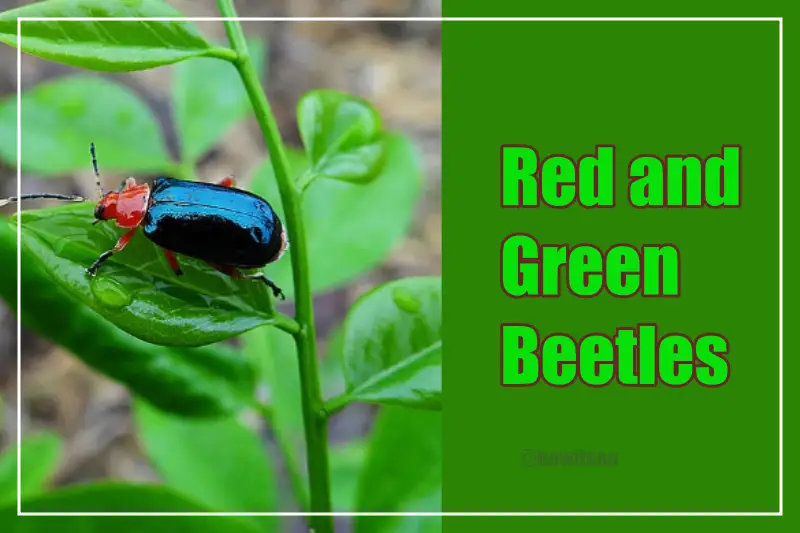Beetles, with 400,000 known species, are the most diverse group of animals in the world. Red and green beetles are fascinating creatures that come in many shapes and sizes.
They are well-adapted to the environment and can live in water, land, air, etc. Elytra (hard forewings) are the most interesting feature of beetles, which occur in many color forms and textures.
In previous articles, you must have read about certain beetles. In this blog post, we will discuss about 15 fascinating red and green beetle species. So let’s start this marvelous journey about beetles.
15 Green and Red Beetles
1. Red-green Leaf beetle
| Scientific name | Disonycha varicornis |
| Size | 6-7 mm |
| Diet | Amaranth plants |
| Geographical location | Central and North America |
These red and green beetles are also known as the flea beetle because of their jumping ability, like fleas. They are adapted to various habitats in Central and North America. Let’s talk about their appearance.
They have black and brown bodies with a metallic sheen. It shows a characteristic red and green color. They are herbivorous and mostly feed on plant foliage and amaranth plants. This diurnal species can jump up to 20 cm. They are first described by Henry Horn.
2. Spotted Flower beetle
| Scientific name | Stephanorrhina guttata |
| Size | 25 mm |
| Diet | No information |
| Geographical location | Cameroon, Nigeria, Kenya, and Tanzania |
They are also known as “spotted flower beetles” and have a body size of 25 mm. They have bright metallic green and red coloration and have white spots on their forewings.
It shows dramatic sexual dimorphism. Males have two short horns. They are popular among insect keepers because of their easy management and because they can live for months in captivity.
They are known as “flower beetles” because they pollinate flowers.
3. Birch shield bug
| Scientific name | Elasmostethus interstinctus |
| Size | 8- 11.5 mm |
| Diet | feed on Birch tree |
| Geographical location | Northern America, Europe, and Northern Asia |
Diurnal insects, known as “birch shield bugs” because of their feeding habits and foul-smelling excretion, are found in the holarctic range, which includes North America, Europe, and northern Asia.
They are green with distinctive red and white patterns on their elytra. Although they are not harmful to birch trees, they can be a nuisance in large numbers. These beetles use their bright, cryptic coloration to warn predators.
4. Raspberry-pistachio clown weevil
| Scientific name |
Pachyrrhynchus purpureus |
| Size | 2 cm |
| Diet | Sap feeder |
| Geographical location | Philippines |
Raspberry-pistachio clown weevil is a common name for Pachyrrhynchus purpureus. They are often collected by insect enthusiasts because of their beautiful, bright coloration.
This Philippine native species usually feeds on tree sap and leaves. They are green and have purplish-red spots all over the body that resemble raspberry and pistachio; that’s why they got their name.
5. Golden jewel beetle
| Scientific name | Buprestis aurulenta |
| Size | 17 mm |
| Diet | plant foliage and nectar |
| Geographical location | North America and Mexico |
Buprestis aurulenta, or “Golden Jewel Beetle,” belongs to the family Buprestidae and got its name as they have metallic green coloration with orangish-red wing margins.
They are found in North America and Mexico, inhabiting coniferous trees, and can attain a size of up to 17 mm. If you want to see this creature, then April to August will be a good time for you, as they are active during that time.
6. Rainbow scarab
| Scientific name | Phanaeus vindex |
| Size | 1-2.2 cm |
| Diet | Coprophagous |
| Geographical location | Eastern United States |
It is easy to distinguish between males and females in this species. Males have a large horn on the dorsal surface of their heads, which is absent in females.
They have a metallic appearance, which imparts many colors like blue, green, red, orange, etc. This native beetle species in the United States usually prefers to feed on animal dung.
Phanaeus vindex also has a great preference for human dung. They act as intermediate hosts for stomach worms.
7. Sulcophanaeus imperator
| Scientific name | Sulcophanaeus imperator |
| Size | 18-28 mm |
| Diet | Coprophagous |
| Geographical location | Argentina, Bolivia, Paraguay |
This flightless, brightly colored beetle is commonly found in Argentina, Bolivia, and Paraguay. They have a characteristic metallic green body with red and black elytra and horns on the dorsal surface of their heads.
Their diet is coprophagous, which means they usually feed on dung. Their mating ritual is also quite interesting; males fight with each other by using their horns, and those who win will mate with the potential females.
They dig tunnels into the soil to make nests and search for food.
8. Cherry Jewel Beetle
| Scientific name | Anthaxia candens |
| Size | 7-11 mm |
| Diet | phytophagous |
| Geographical location | Southern and Central Europe |
Also known as candle beetles or green jewel beetles, their remarkable metallic coloration resembles the color of the candle flame. They are greenish-blue in color, with red elytra having black markings.
This European beetle species can attain a length of up to 7–11 mm. They are active during the day and feed on plant parts and nectar. Their larvae are tree borers and feed on tree sap.
9. Rainbow stag beetle
| Scientific name | Phalacrognathus muelleri |
| Size | 24-70 mm |
| Diet | Decaying wood |
| Geographical location | Queensland, Australia, New Guinea |
Phalacrognathus muelleri, also known as the rainbow stag beetle, belongs to the Lucanidae family. People find this multicolored beetle in Queensland, Australia, and New Guinea.
Males of this species are larger than females; males range from 24 to 70 mm in length, whereas the smaller females range from 23 to 46 mm.
According to recent news, their numbers are declining in Queensland due to habitat loss. Scientists asked the government to initiate some programs to conserve these species.
10. Rainbow leaf beetle
| Scientific name | Chrysolina cerealis |
| Size | 5.5-10 mm |
| Diet | Flowers and leaves of wild thyme |
| Geographical location | United Kingdom |
The rainbow leaf beetle got its name due to its appearance. They are metallic green in color with three longitudinal blue and red stripes. Females of this beetle species are larger than males.
They are active from April to September and mostly feed on wild thyme. This species is rare and protected under the Wildlife and Countryside Act, of 1981, in the United Kingdom.
11. Southern green stink bug
| Scientific name | Nezara viridula |
| Size | 13 mm |
| Diet | Legumes, cereals mainly |
| Geographical location | America, Australia, Asia, Africa, and Europe |
Southern green stink beetle or red and green stink beetle are common names for this beetle. They are believed to have originated in Ethiopia but are found all across the world.
They have a green body with red marginal spots and white spots. It is considered a pest on certain plants like beans, soybeans, cotton, tomatoes, etc. They are about 13 mm long and mate throughout the year in the tropics. They lay up to 30 to 130 eggs at a time.
12. Red green Scarab beetle
| Scientific name | Plusiotis adelaida |
| Size | 20-25 mm |
| Diet | Phytophagous |
| Geographical location | Mexico and Central America |
You can find these magnificent beetles in Mexico and Central America. They are large in size and can attain a length of up to 20–25 mm. They are green with green and reddish stripes on their elytra.
This nocturnal beetle attracts light at night. The adults of this harmless beetle usually feed on plant foliage. People used to use them as jewelry or ornaments in ancient times, which is why they are also known as jewel beetles.
According to Egyptian mythology, they symbolize eternal life, protection, vitality, and renewal. There is no information available about their life spans.
13. Common Malachite Beetle
| Scientific name | Malachius bipustulatus |
| Size | 5.5-6 mm |
| Diet | Omnivorous |
| Geographical location | England and wales |
If you are an insect collector, then you must have known about these beautiful beetles. Malachius bipustulatus is known for its distinctive coloration.
They are brownish with green metallic elytra and have red spots on their anterior end or the margins. They are quite small beetles, with an average size of 5-7 mm. Their mating behavior is unique.
Their males attract females by producing a secretion from their antennae, which females consume before mating. They are univoltine and find in meadows in England and Wales.
14. Redbanded Stink Bug
| Scientific name | Piezodorus guildinii |
| Size | 8-11 mm |
| Diet | Pods and reproductive structures of plants |
| Geographical location | Central and South America |
Piezodorus guildinii has a glossy, green appearance and a single red band on its pronotum. It poses a serious threat to leguminous plants, such as soybeans, etc., in South America, leading to reductions in soybean quantity.
The stink bug is medium-sized and can reach a size of 8–11 mm. Several species of wasps parasitize their eggs and nymphs, and people use them as biocontrol agents in threatened areas.
15. Pachycoris torridus
| Scientific name | Pachycoris torridus |
| Size | no information |
| Diet | Plant foliage and nectar |
| Geographical location | South and Central America, Asia |
Conclusion
In conclusion, we can say that red and green beetles are unique organisms with distinctive features. Apart from their appearance, they also act as pests on certain plant species. They are also used as biocontrol agents.
If you are an insect lover, then this article on red and green beetles is going to be very interesting and informative for you!
Also Read:

Being a zoology student I’m always been fascinated toward animals especially insects. I love to do research and learn about different animals. As a writer I want to share my thoughts about nature through my articles. Apart from this you can find me exploring the new places and voice notes.
